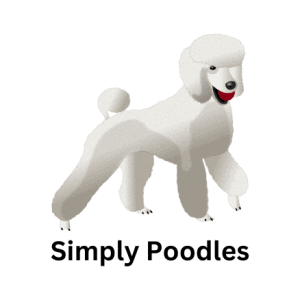What is a Goldendoodle?
The Goldendoodle is the offspring of a Golden Retriever and a Poodle. Both the Golden Retriever and the Poodle are considered highly intelligent, friendly dogs. The goldendoodle is a very trainable, kind, outgoing dog that doesn’t drool. They are promoted as hypoallergenic. These traits make them an excellent family pet and they make great companions for people with disabilities. The goldendoodle is quickly becoming a very popular dog breed across the United States.
According to Vetstreet.com the Goldendoodle is number one on the list of hottest dog breeds. This personable, charming dog has risen an amazing 128 places over a 10-year period. The Goldendoodle is also listed as a popular mixed dog breed in this article by petfriendlyhouse.com.
History of the Goldendoodle
The exact date of the first Goldendoodle is unknown. There are reports that goldendoodles were first bred in 1969 to be guide dogs. The hybrid known as the goldendoodle gained popularity in the 1990’s as several breeders began to promote this popular designer dog. Goldendoodles are considered a designer breed as each of their parents is a purebred dog.
The Goldendoodle is one of the more recent of the Doodle mix breeds. The Cockapoo is considered the first of the Doodle mix breed and is a mix between a Cocker Spaniel and a Poodle. Next was the Labradoodle, a cross between a Labrador Retriever and a Poodle. The question arises, why is the Poodle so popular for crossbreeding? One reason is that the Poodle is considered one of the smartest dog breeds in the world, according to canine psychologist Stanley Coren in his book. The Intelligence of Dogs. The Poodle ranked number 2 in the world for intelligence while the Golden Retriever came in at number 4. Coren came to this conclusion by surveying over 190 dog obedience judges. Here is the list he compiled:
Top 10 Smartest Dogs
1. Border collie
2. Poodle
3. German shepherd
4. Golden retriever
5. Doberman pinscher
6. Shetland sheepdog
7. Labrador retriever
8. Papillon
9. Rottweiler
10. Australian cattle dog
The result of breeding the Golden Retriever and the Poodle is an exceptionally smart dog.
Why is the Goldendoodle so Popular?
By selecting the right parents crossing purebred dogs of mixed breeds produces puppies that are healthier than either of their parents. The reason for this is that each breed is typically prone to different genetic problems. Designer hybrids like the Goldendoodle are likely to inherit only a health problem that is common to both the Golden Retriever and the Poodle. Fortunately, these two breeds share few common diseases. The result is that Goldendoodles have a “hybrid vigor” which can be expected to live a healthier longer life than each of their parents.
The blend of these two purebred dogs produces a hybrid dog that with careful breeding produces a dog that is friendly, smart, affectionate, social and playful. Typically, the desirable qualities of the golden retriever including the loving, gentle, desire to please qualities combined with the intelligence and energy of the poodle make for a great family pet or a companion dog.
Additionally, the Goldendoodle wants to run, play, and swim with their owners, inheriting their parents love for the water. They are usually “up” for a good game of tug-of-war or for fetching a ball. When you’re relaxing, Goldendoodles are happy to lay at your feet or snuggle with you. It’s easy to understand why the Goldendoodle has become so popular.
Appearance and Coat
Although most people think of Goldendoodles as being “golden” in color, they come in a number of colors including:
Apricot, Black, Chocolate, Cream, Red, Silver, White, and Multi colored. If the goldendoodle is at least 50% white along with solid patches of another color they are referred to as a Parti Goldendoodle which has become very desirable among doodle lovers.
One of the endearing qualities of the Goldendoodles is that they often look like huggable, soft teddy bears. Who doesn’t want to hug a soft teddy bear? They can have different types of coats but most tend to have a wavy coat with minimal or no shedding. Goldendoodles with a curly coat have inherited more of the Poodles genes and rarely shed. It’s unusual to see a goldendoodle with a straight coat although it does happen. To prevent matting Goldendoodles need to be brushed regularly and clipped every few months.
What Size are Goldendoodles?
There are 4 different sizes of Goldendoodles According to the Goldendoodle Association of North America.
Standard Size: Over 21 inches tall at the wither (the ridge between the shoulder blades of the dog) and weighing 51 or more pounds. This is the most common Goldendoodle size. The standard size Goldendoodle is athletic and strong and need space to run and exercise. They make terrific companions for those who prefer larger dogs.
Medium Size: Over 17 inches tall but under 21 inches tall at the wither, usually weighing 36 to 50 pounds.
Miniature Size: Over 14 inches tall but under 17 inches tall at the wither, usually weighing 26 to 35 pounds.
Petite Size: Under 14 inches tall and usually 25 pounds or less. Obviously the best size for smaller homes and apartments.
Different Generations of Goldendoodles
Here is an explanation of Goldendoodle generations which defines degree of Golden Retriever bred with degree of Poodle:
F1 = Golden Retriever x Poodle – This is a purebred Poodle bred with a purebred Golden Retriever. These tend to be low to non-shedding pups. They are generally healthier than both parent dogs. Although these can be good for those with mild allergies it is recommended obtaining an F1b or higher generation for those with allergies.
F1b = F1 Goldendoodle x Poodle – This is an F1 Goldendoodle crossed with a purebred Poodle. F1b tend to be lower shedding than the F1 cross as they typically have more influence from the Poodle. The F1b dog or higher is recommended for those with allergies.
F1bb = F1b Goldendoodle x Poodle – F1bb’s tend to be non-shedding.
F2 = F1 Goldendoodle x F1 Goldendoodle – The F2 dogs can vary significantly in regards to shedding. They can be non-shedding, low shedding, or heavy shedding.
Note: After the F2 generation there is discussion on how to describe additional generations in regards to proper terminology.
F2b = F1b Goldendoodle x F1 Goldendoodle – These dogs are typically non-shedding and good for allergy sufferers.
F3 = F1b Goldendoodle x F1b Goldendoodle or F2 Goldendoodle x F2 Goldendoodle – These dogs should also be non-shedding and good for allergy sufferers.
Multigen = Any Goldendoodle breeding consisting of F3 or higher dogs.
Observing different generations helps predict traits of the puppy. In theory if an F1 Goldendoodle is bred with a Poodle you would produce a litter that is 75% Poodle and 25% Golden Retriever. The reality is half of the puppies may receive a majority of the Poodle traits and half may receive a majority of the Golden Retriever traits. It is not an exact science.
We will discuss generations of Goldendoodles more in depth in a future article.
How long do Goldendoodles Live?
Goldendoodles typically live 10 to 15 years so they will be part of your family for a long time. This takes into account the average lifespan for both Golden Retrievers and Poodles. There are many things that contribute to how long a Goldendoodle will live.
For example, if the Goldendoodle exercises, eats a healthy diet and makes regular visits to the veterinarian he will typically live longer than a dog who does the opposite. Although we can’t completely control how long our Doodle will live, we can provide the best care possible to promote a long, healthy life.
What are Goldendoodle Health Issues?
Although these health issues are not typical, they can occur in Goldendoodles:
While every breed of dog is prone to some health issues, here are the health issues which are more specific to Goldendoodles.
Atopic Dermatitis – This is an allergic skin disease which is common in many breeds, not just Goldendoodles.
Cranial Cruciate Ligament Rupture – the cruciate ligament stabilizes the knee joint during its hinged motion bearing a tremendous amount of strain. The ligament can rupture or degenerate over time.
Epilepsy – Typically become evident in Goldendoodles the first time between six months to five years of age, either as petite mal episodes or grand mal convulsive seizures. A veterinarian will need to determine the appropriate treatment.
Hip Dysplasia – This occurs when the hip joint fails to develop normally in young Goldendoodles and is inherited. This can be detected through radiography scoring. Those dogs showing signs of dysplasia should be removed from breeding.
Patellar Luxation – This is a slight anatomic abnormality causing the kneecap to slip out of position when the dog is exercising.
Progressive Retinal Atrophy – Degeneration of retinal nerve cells resulting in night blindness, progressing to significant loss of vision in middle-aged Goldendoodles. This is not unusual in many pedigree and hybrid animals.
Von Willebrand Disease – Poor platelet function resulting in a clotting disorder causing heavy bleeding, even from minor cuts and abrasions.
Having listed the typical health issues for the Goldendoodle doesn’t mean we need to be hypochondriacs about this list. These are only potential issues which may never occur in your Goldendoodle. Plus, many breeders have their dogs tested to reveal most of these health issues to prevent litters prone to having such issues. The Goldendoodle tends to have excellent health if bred responsibly.
Conclusion
Goldendoodles are gentle, social animals making them a terrific option for first time dog owners. They are a natural friend to children and other pets.
The combination of the obedience and willingness to please of the Golden Retriever combined with the intelligence of the Poodle make this designer dog an excellent therapy, service or sniffer dog.
They make wonderful family pets, ready to play, cuddle, or just hang out together. It’s easy to see why they have quickly become so popular!

